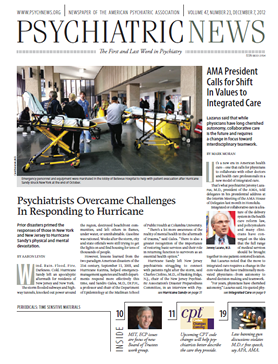Each year in the United States, almost 2 million people sustain a traumatic brain injury (TBI); it is the second most common neurologic disorder (after headache), and more common than stroke and Alzheimer’s disease. The “signature injury” of our wounded warriors from Iraq and Afghanistan, athletes who sustain concussions, and former Rep. Gabrielle Giffords’ traumatic brain injury has increased the awareness of the extent of this disorder.
While attention is often focused on physical and cognitive sequelae, the occurrence of psychiatric disorders is significant and complicates functioning and treatment. While neurologists, physiatrists, and internists see many individuals with TBI, psychiatrists have a critical role to play in the treatment of these patients. We need to know the common physical sequelae (such as vestibular and visual problems, headaches), as well as the appropriate evaluation and treatment of emotional and behavioral problems (irritability, depression, anxiety, fatigue, sleep disorders).
There are several important facts that psychiatrists should know when evaluating a patient who has sustained a mild TBI. First, one does not have to lose consciousness to sustain a concussion: any alteration in sensorium (including feeling dazed, seeing stars, and so on) is sufficient for the diagnosis of TBI. Second, medical records are often inaccurate (up to 50 percent of concussions are missed in the emergency room). Third, patients confuse “posttraumatic amnesia” (where they do not remember what happened for a period before and after the injury) with being unconscious. Unless there is a witness, the patients know only that they have no recall—not whether they were unconscious. Fourth, imaging modalities (MRI, CT) are most often normal. Newer techniques such as DTI (diffusion tensor imaging) are promising, but “not ready for prime time.” Lastly, the vast majority of individuals with a concussion have significant or complete recovery within a few months. Thus, it is important to be optimistic regarding recovery. In fact, the presence of psychiatric disorders is a major factor in impairing ability to function following injury.
After TBI, there is an increased risk of developing almost every psychiatric disorder, especially depression and anxiety. In patients who have suffered trauma, the presence of TBI increases the likelihood of posttraumatic stress disorder (PTSD), panic disorder, agoraphobia, and social phobia; and it is the psychiatric disorder, not TBI, that increases the likelihood of self-reported functional impairment. Multiple studies have shown that coexistent anxiety or depression increases the severity of postconcussive symptoms, and psychological distress and results in poorer outcome as well as impaired performance on neuropsychological tests.
In soldiers who have returned from Iraq and Afghanistan, the presence of PTSD is more strongly correlated with “postconcussive” symptoms and health and psychosocial outcomes than is the occurrence of a mild TBI. Symptoms of PTSD overlap with symptoms following concussion, and PTSD may occur in situations where a mild brain injury also occurs. It is important, but difficult, for clinicians to sort out when symptoms are due to PTSD and not the lingering effects of brain injury.
Because those who have sustained a traumatic brain injury almost, by definition, have experienced a traumatic event, the emotional and psychological repercussions of the event must be explored. Depression, anxiety, irritability, in addition to problems with concentration, memory, fatigue, and sleep, can improve with appropriate and informed treatment, including pharmacologic modalities. Psychiatrists need to be aware of the evidence substantiating the treatment options to provide patients the best care possible. Lastly, since TBI is one of the few preventable neuropsychiatric disorders, we need to counsel our patients regarding appropriate interventions, including the dangers of cell phone use (even hands free) while driving or walking. To provide a professional example, I suggest that physicians should not call our patients while either we or they are driving.

Jonathan Silver, M.D., is a clinical professor of psychiatry at the New York University School of Medicine. He is a past president and fellow of the American Neuropsychiatric Association and a diplomate in behavioral neurology and neuropsychiatry from the United Council for Neurologic Subspecialties. He is a coauthor of the Textbook of Traumatic Brain Injury, Second Edition, by American Psychiatric Publishing. Members can purchase the book at a discount at www.appi.org/SearchCenter/Pages/SearchDetail.aspx?ItemId=62357.

